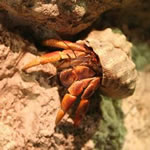
Biologists
studying hermit crabs in a tiny island in the Caribbean Sea discovered
something interesting: they're quite civilized!
When a lone crab encountered one of the beautiful new shells, it
immediately inspected the shelter with its legs and antennae and scooted
out of its current home to try on the new shelter for size. If the new
shell was a good fit, the crab claimed it. Classic hermit crab behavior.
But if the new shell was too big, the crab did not scuttle away disappointed—instead,
it stood by its discovery for anywhere between 15 minutes and 8 hours,
waiting. This was unusual. Eventually other crabs showed up, each one
trying on the shell. If the shell was also too big for the newcomers,
they hung around too, sometimes forming groups as large as 20. The crabs
did not gather in a random arrangement, however. Rather, they clamped
onto one another in a conga line stretching from the largest to smallest
animal—a behavior the biologists dubbed "piggybacking."
Only one thing could break up the chain of crabs: a Goldilocks
hermit crab for whom the shell introduced by Lewis and Rotjan was just
right. As soon as such a crab claimed its new home, all the crabs in
queue swiftly exchanged shells in sequence. The largest crab at the
front of the line seized the Goldilocks crab's abandoned shell. The
second largest crab stole into the first's old shell. And so on.
 Biologists
studying hermit crabs in a tiny island in the Caribbean Sea discovered
something interesting: they're quite civilized!
Biologists
studying hermit crabs in a tiny island in the Caribbean Sea discovered
something interesting: they're quite civilized!
No comments:
Post a Comment